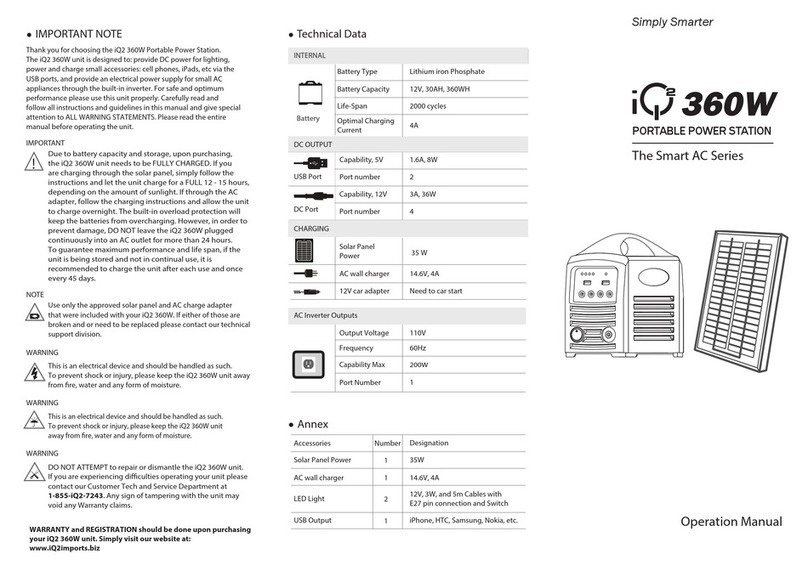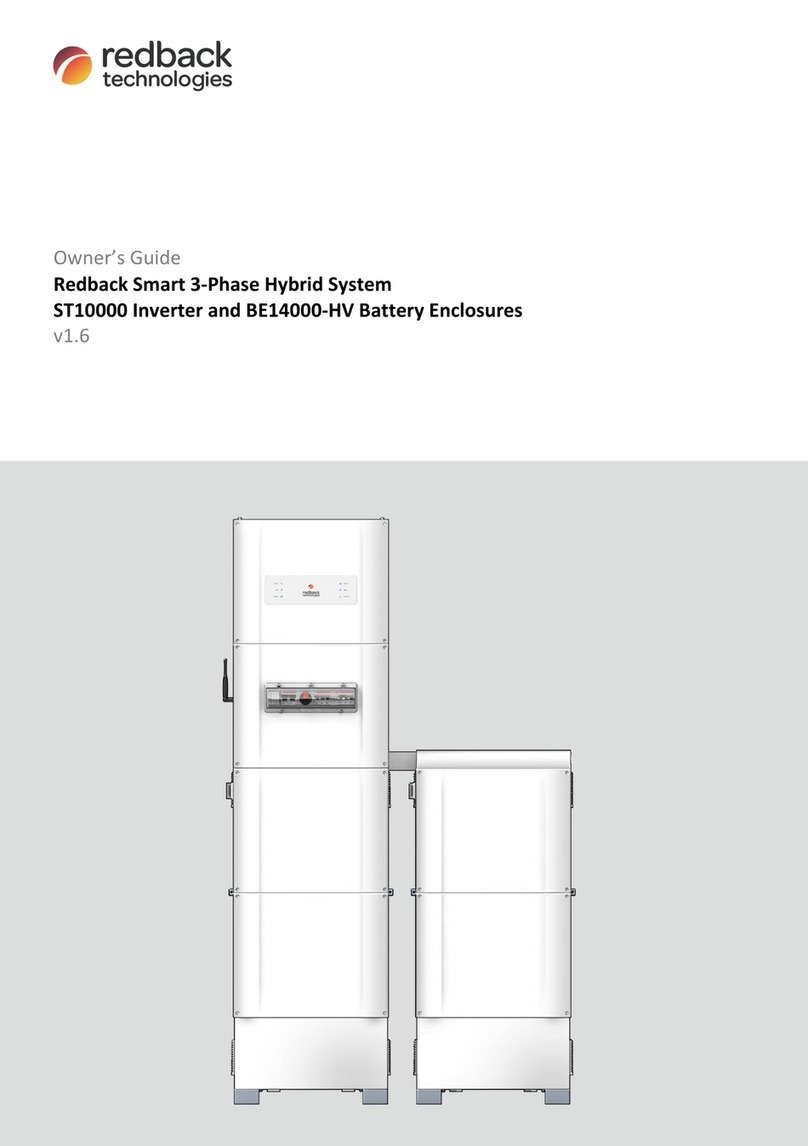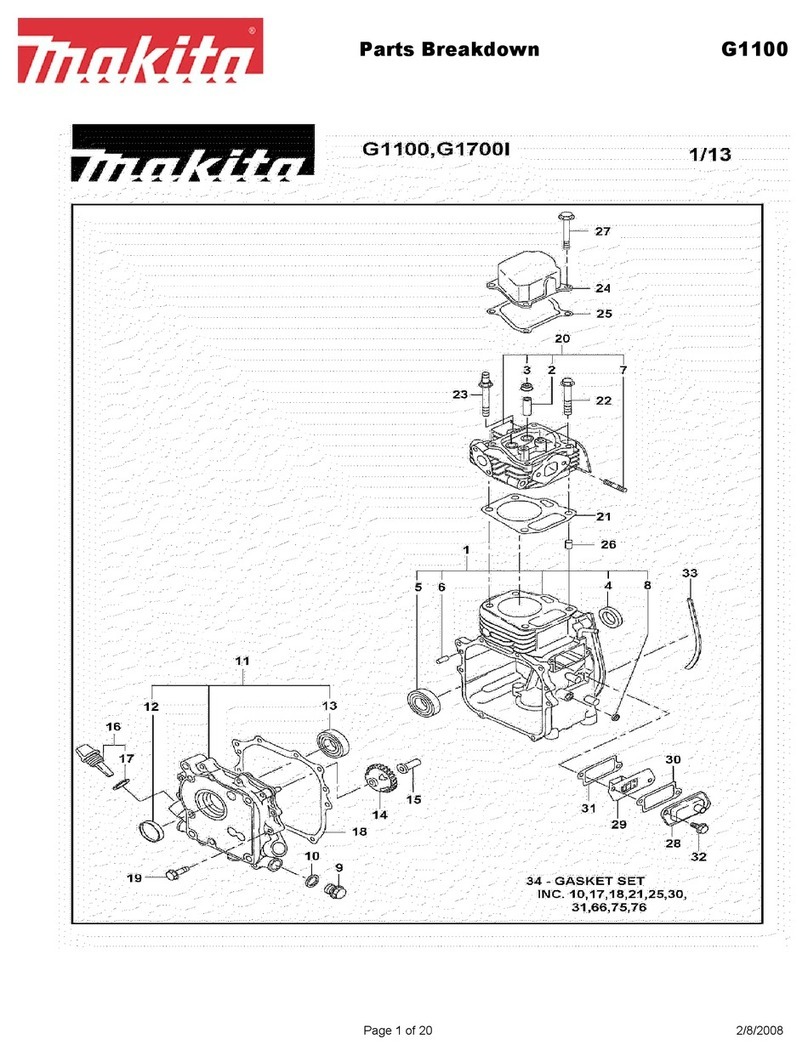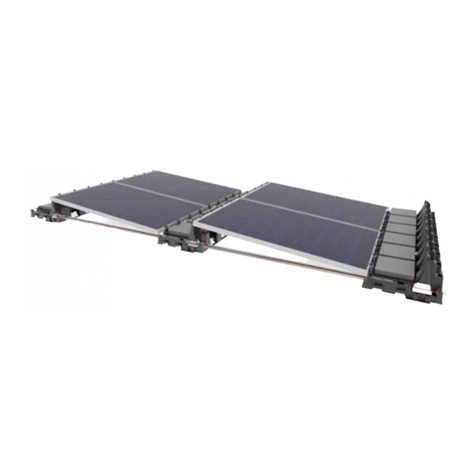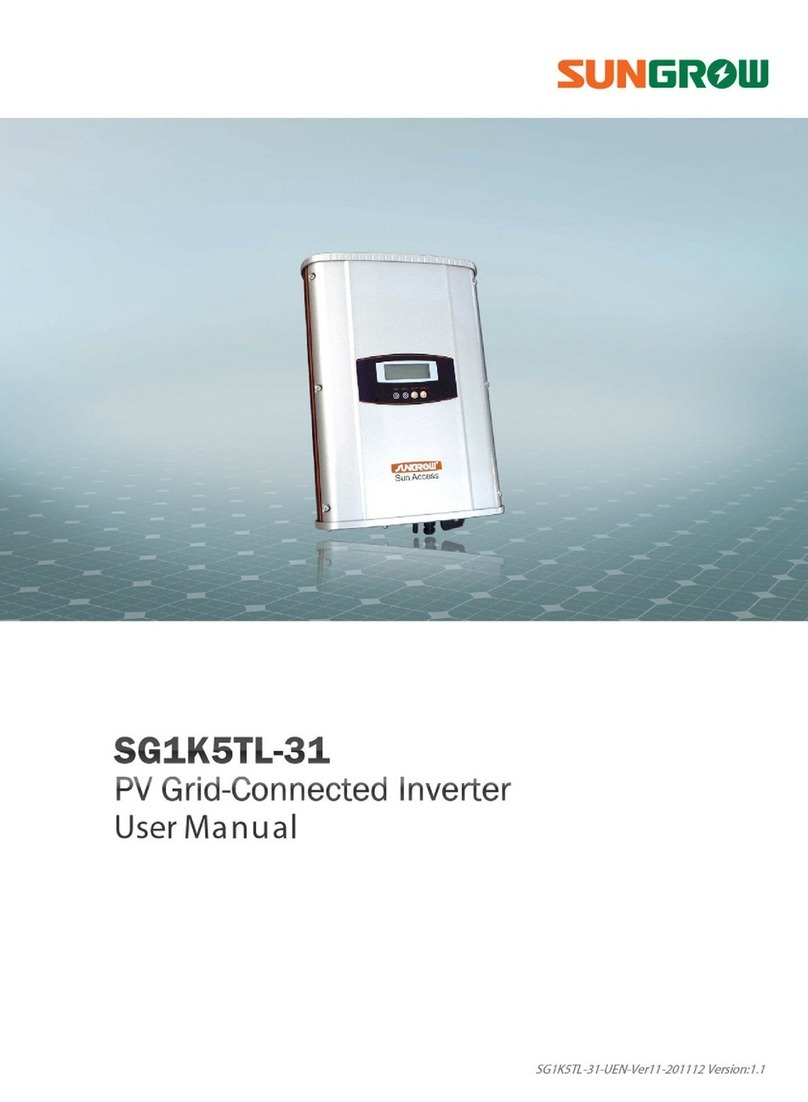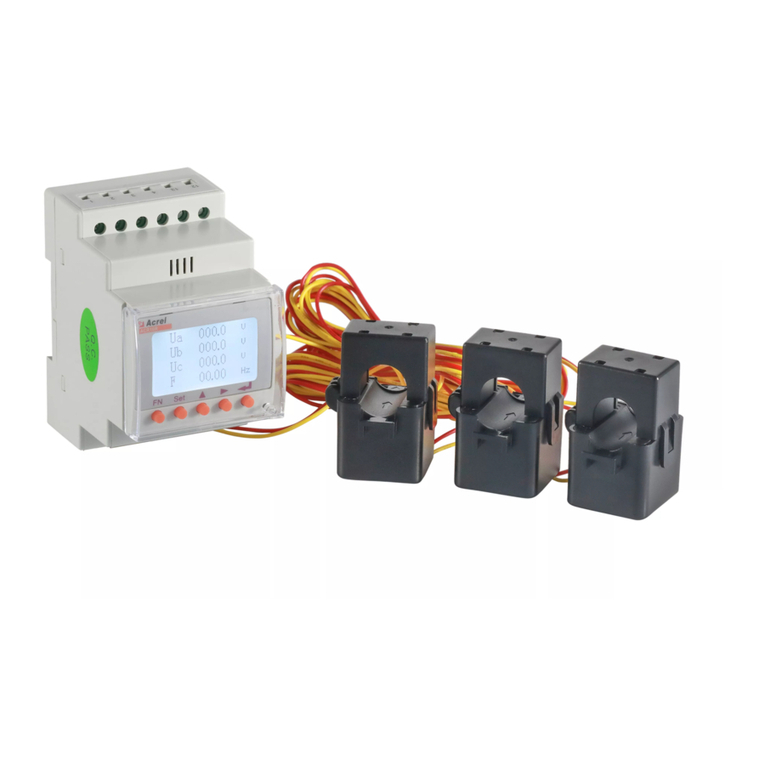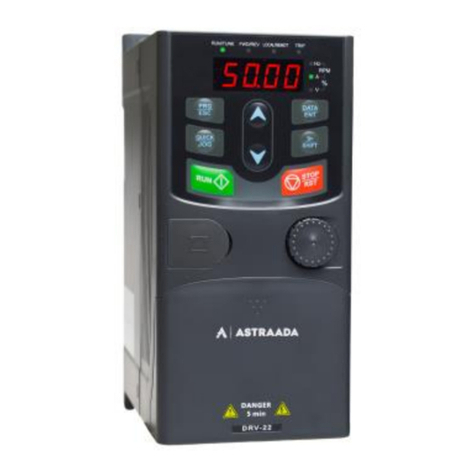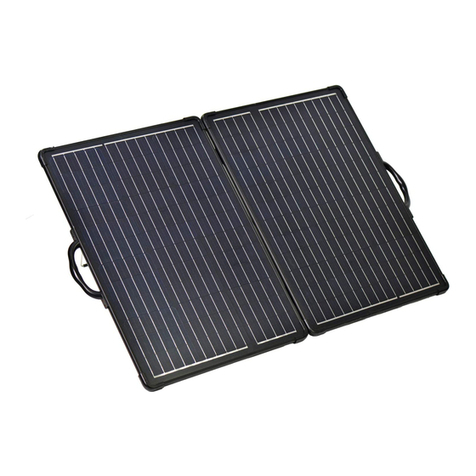Bovie ids-400 User manual


i
User’s Guide • Bovie®IDS-400
USER’S GUIDE

ii Bovie Medical Corporation

This manual and the equipment it describes are for use only by qualified medical professionals trained in the particular technique
and surgical procedure to be performed. It is intended as a guide for using the Bovie®IDS-400 only.
Additional technical information is available in the Bovie®IDS-400 Service Guide.
Equipment Covered in this Manual
Bovie IDS-400:
Reference No.: IDS-400
For Information Contact
Bovie Medical Corporation • 5115 Ulmerton Road, Clewarwater, FL 33760-4004 USA
U.S. Phone 1-800-537-2790 Fax 1-800-323-1640 • International Phone +1-727-384-2323 Fax +1-727-347-9144
www.boviemed.com • info@boviemed.com
©2014 Bovie Medical Corporation.All rights reserved. Contents of this publication may not be reproduced without the written
permission of Bovie Medical Corporation.
Bovie Part Number MC-55-131-001 Rev. 4
CONVENTIONS USED IN THIS GUIDE
WARNING:
Indicates a potentially hazardous situation which, if not avoided, could result in death or serious
injury.
CAUTION:
Indicates a hazardous situation which, if not avoided, may result in minor or moderate injury.
NOTICE:
Indicates an operating tip, a maintenance suggestion, or a hazard that may result in product
damage.
iii
User’s Guide • Bovie®IDS-400

TABLE OF CONTENTS
Equipment Covered in this Manual............................................................................iii
For Information Contact .............................................................................................iii
Conventions Used in this Guide ........................................................................................iii
Introducing the Bovie®IDS-400...........................................................................................1-1
Indications For Use .........................................................................................................1-2
Safety ..............................................................................................................................1-2
Contraindications.....................................................................................................1-5
Key Features...................................................................................................................1-5
Components and Accessories.........................................................................................1-7
Controls, Indicators, and Receptacles................................................................................2-1
Front Panel......................................................................................................................2-2
Symbols on the Front Panel....................................................................................2-3
Preset Controls................................................................................................................2-4
Cut and Blend Controls...................................................................................................2-5
Coag Controls .................................................................................................................2-6
Bipolar Controls...............................................................................................................2-7
Indicators.........................................................................................................................2-8
Power Switch and Receptacles.......................................................................................2-9
Rear Panel ....................................................................................................................2-10
Symbols on the Rear Panel ..................................................................................2-10
Getting Started ......................................................................................................................3-1
Initial Inspection ..............................................................................................................3-2
Installation .......................................................................................................................3-2
Function Checks..............................................................................................................3-2
Setting Up the Unit..................................................................................................3-2
Checking the Return Electrode Alarm.....................................................................3-2
Confirming Modes ...................................................................................................3-3
Checking Bipolar Mode (with bipolar footswitch) ....................................................3-3
Checking Monopolar Mode (with monopolar footswitch) ........................................3-3
Checking Monopolar Mode (with handswitch) ........................................................3-3
Performance Checks.......................................................................................................3-3
Using the Bovie®IDS-400.....................................................................................................4-1
Inspecting the Generator and Accessories .....................................................................4-2
Setup Safety....................................................................................................................4-2
Setting Up .......................................................................................................................4-3
Preparing for Monopolar Surgery....................................................................................4-4
Applying the Return Electrode ................................................................................4-4
Connecting Accessories..........................................................................................4-4
Blend Controls.........................................................................................................4-4
Setting and Recalling Memory Presets...........................................................................4-5
Memory....................................................................................................................4-5
Memory Function Overview.....................................................................................4-5
Setting Your Presets................................................................................................4-6
Memory Feature (Last Selected Preset) .................................................................4-6
Activating the Unit ...........................................................................................................4-7
Activation Safety..............................................................................................................4-7
Maintaining the Bovie®IDS-400...........................................................................................5-1
Cleaning ..........................................................................................................................5-2
Periodic Inspection..........................................................................................................5-2
Fuse Replacement ..........................................................................................................5-2
iv Bovie Medical Corporation

Troubleshooting ....................................................................................................................6-1
Repair Policy and Procedures .............................................................................................7-1
Responsibility of the Manufacturer..................................................................................7-2
Returning the Generator for Service ...............................................................................7-2
Step 1 – Obtain a Returned Goods Authorization Number.....................................7-2
Step 2 – Clean the Generator.................................................................................7-2
Step 3 – Ship the Generator ...................................................................................7-3
Technical Specifications......................................................................................................A-1
Performance Characteristics...........................................................................................A-2
Input Power.............................................................................................................A-2
Duty Cycle...............................................................................................................A-2
Dimensions and Weight..........................................................................................A-2
Operating Parameters.............................................................................................A-2
Transport and Storage ............................................................................................A-2
Audio Volume..........................................................................................................A-3
Return Electrode Sensing.......................................................................................A-3
Low Frequency (50-60 Hz) Leakage Current .........................................................A-3
High Frequency (RF) Leakage Current ..................................................................A-4
Standards and IEC Classifications .................................................................................A-4
Class I Equipment (IEC 60601-1)...........................................................................A-4
Type CF Equipment (IEC 60601-1) / Defibrillator Proof .........................................A-4
Drip Proof (IEC 60601-2-2).....................................................................................A-4
Electromagnetic Interference ..................................................................................A-4
Electromagnetic Compatibility (IEC 60601-1-2 and IEC 60601-2-2)......................A-4
Voltage Transients (Emergency Generator Mains Transfer) ..................................A-4
Output Characteristics ....................................................................................................A-5
Maximum Output for Monopolar and Bipolar Modes..............................................A-5
EMC Compliance............................................................................................................A-5
Output Power Curves .....................................................................................................A-9
Warranty ................................................................................................................................B-1
v
User’s Guide • Bovie®IDS-400

LIST OF FIGURES
Figure 2 – 1 Layout of controls, indicators, and receptacles on the front panel..................2-2
Figure 2 – 2 Controls for setting and recalling presets........................................................2-4
Figure 2 – 3 Controls for the Cut and Blend modes............................................................2-5
Figure 2 – 4 Controls for the Coag mode ............................................................................2-6
Figure 2 – 5 Controls for the Bipolar mode .........................................................................2-7
Figure 2 – 6 Indicators for power, return electrodes, and footswitch control.......................2-8
Figure 2 – 7 Location of the unit power switch and front panel receptacles .......................2-9
Figure 2 – 8 Layout of connectors and controls on the rear panel....................................2-10
Figure 5 – 1 Fuse holder......................................................................................................5-2
Figure A – 1 Output power versus voltage for all modes ....................................................A-9
Figure A – 2 Output power vs impedance for Cut I mode ................................................A-10
Figure A – 3 Output power vs impedance for Cut II mode ...............................................A-10
Figure A – 4 Output power versus impedance for Blend mode.........................................A-11
Figure A – 4 Output power versus impedance for Pinpoint mode.....................................A-11
Figure A – 6 Output power vs impedance for Spray mode ...............................................A-12
Figure A – 7 Output power vs impedance for Bipolar mode .............................................A-12
vi Bovie Medical Corporation

1-1
User’s Guide • Bovie®IDS-400
INTRODUCING THE BOVIE®IDS-400
This section includes the following information:
●●Indications For Use
●●Safety
●●Warnings and Cautions
●●Key Features
●●Components and Accessories
●●Additional Accessories
CAUTIONS:
Read all warnings, cautions, and instructions provided with this generator before using.
Read the instructions, warnings, and cautions provided with electrosurgical accessories before
using. Specific instructions are not included in this manual.

INDICATIONS FOR USE
The Bovie®IDS-400 Electrosurgical Generator is used to deliver RF energy via an assortment of surgical devices to cut and
coagulate different kinds of tissue.
SAFETY
The safe and effective use of electrosurgery depends to a large degree on factors solely under the control of the operator. There is no
substitute for a properly trained and vigilant medical staff. It is important that they read, understand, and follow the operating
instructions supplied with this electrosurgical equipment.
Physicians have used electrosurgical equipment safely in numerous procedures.Before starting any surgical procedure, the surgeon
should be familiar with the medical literature, complications, and hazards of using electrosurgery in that procedure.
To promote the safe use of the Bovie®IDS-400, this section presents the warnings and cautions that appear throughout this user’s
guide. It is important that you read, understand, and follow the instructions in these warnings and cautions so that you can operate
this equipment with maximum safety. It is also important that you read, understand, and follow the instructions for use in this
user’s guide.
WARNINGS:
Hazardous Electrical Output - This equipment is for use only by trained, licensed physicians.
Danger: Fire / Explosion Hazard - Do not use the Bovie®IDS-400 in the presence of flammable
materials.
Fire / Explosion Hazard - The following substances will contribute to increased fire and explosion
hazards in the operating room:
• Flammable substances (such as alcohol based skin prepping agents and tinctures)
• Naturally occurring flammable gases which may accumulate in body cavities such as
the bowel
• Oxygen enriched atmospheres
• Oxidizing agents (such as nitrous oxide [N20] atmospheres).
The sparking and heating associated with electrosurgery can provide an ignition source.
Observe fire precautions at all times. When using electrosurgery in the same room with any
of these substances or gases, prevent their accumulation or pooling under surgical drapes, or
within the area where electrosurgery is performed.
Connect the power cord to a properly polarized and grounded power source with the frequency
and voltage characteristics that match those listed on the back of the unit.
Electric Shock Hazard - Connect the generator power cord to a properly grounded receptacle.
Do not use power plug adapters.
Electric Shock Hazard - Always turn off and unplug the generator before cleaning.
Fire Hazard - Do not use extension cords.
Patient Safety - Use the generator only if the self-test has been completed as described.
Otherwise, inaccurate power outputs may result.
Failure of the high frequency electrosurgical equipment could result in an unintended increase of
output power.
The instrument receptacles on this generator are designed to accept only one instrument at a
time. Do not attempt to connect more than one instrument at a time into a given receptacle. Doing
so will cause simultaneous activation of the instruments.
Use the lowest output setting necessary to achieve the desired surgical effect. Use the active
electrode only for the minimum time necessary in order to lessen the possibility of unintended
burn injury. Pediatric applications and/or procedures performed on small anatomic structures may
require reduced power settings. The higher the current flow, and the longer the current is applied,
the greater the possibility of unintended thermal damage to tissue, especially during use on small
structures.
1-2 Bovie Medical Corporation

WARNINGS:
Use electrosurgery with caution in the presence of internal or external devices such as pacemak-
ers or pulse generators. Interference produced by the use of electrosurgical devices can cause
devices such as pacemakers to enter an asynchronous mode or can block the pacemaker effect
entirely. Consult the device manufacturer or hospital Cardiology Department for further information
when use of electrosurgical appliances is planned for patients with cardiac pacemakers or other
implantable devices
.
If the patient has an Implantable Cardioverter Defibrillator (ICD), contact the ICD manufacturer for
instructions before performing an electrosurgical procedure. Electrosurgery may cause multiple
activation of ICDs.
Do not use electrosurgical equipment unless properly trained to use it in the specific procedure
being undertaken. Use by physicians without such training has resulted in serious, unintended
patient injury, including bowel perforation and unintended, irreversible tissue necrosis.
For surgical procedures where the high frequency current could flow through parts of the body
having a relatively small cross-sectional area, the use of bipolar techniques may be desirable to
avoid unwanted coagulation.
For all Monopolar modes, any associated equipment and active electrodes must be rated to with
stand the combination of output voltage, Vpeak and crest factor as stated in the table on
page A-5.
The generator is equipped with a return electrode sensing and contact quality monitoring system
(NEM), which monitors the quality of the patient return electrode connection. When a correctly
functioning single plate return electrode is connected to the generator, the NEM verifies the con-
nections between the generator and the single return electrode. It DOES NOT verify that a single
return electrode is in contact with the patient. When using a split return electrode, the NEM con-
firms the total resistance is within the preset safety range. Proper application and visual inspection
of the patient return electrode is required for safe operation.
In some circumstances, potential exists for alternate site burns at points of skin contact (e.g.,
between the arm and the side of the body). This occurs when electrosurgical current seeks a path
to the return electrode that includes the skin-to-skin contact point. Current passing through small
skin-to-skin contact points is concentrated and may cause a burn. This is true for grounded,
ground referenced, and isolated output generators.
To reduce the potential for alternate site burns, do one or more of the following:
• Avoid skin-to-skin contact points, such as fingers touching leg, when positioning the patient.
• Place 5 to 8 cm (2 to 3 in.) of dry gauze between contact points to ensure that contact does
not occur.
• Position the return electrode to provide a direct current route between the surgical site and
the return electrode which avoids skin-to-skin contact areas.
• In addition, place patient return electrodes according to the manufacturer’s instructions.
Potential for alternate site burns increases if the return electrode is compromised. Bovie recom-
mends the use of split return electrodes and Bovie generators with a contact quality
monitoring system.
The entire area of the neutral electrode should be reliably attached to the patient’s body and as
close to the operating field as possible.
The cables to surgical electrodes should be positioned in such a way that contact with the patient
or other leads is avoided. Temporarily unused active electrodes should be stored so that they are
isolated from the patient.
Do not wrap the accessory cords or return electrode cords around metal objects. This may induce
currents that could lead to shocks, fires, or injury to the patient or surgical team.
The use of flammable anesthetics or oxidizing gases such as nitrous oxide (N2O) and oxygen
should be avoided if a surgical procedure is carried out in the region of the thorax or the head,
unless these agents are sucked away.
1-3
User’s Guide • Bovie®IDS-400

WARNINGS:
Non-flammable agents should be used for cleaning and disinfection wherever possible.
Flammable agents used for cleaning or disinfecting, or as solvents of adhesives, should be
allowed to evaporate before the application if HF surgery. There is a risk of pooling flammable
solutions under the patient or in body depressions such as the umbilicus, and in body cavities
such as the vagina. Any fluids pooled in these areas should be mopped up before HF surgical
equipment is used. Attention should be called to the danger of ignition of endogenous gases.
Some materials, for example cotton, wool and gauze, when saturated with oxygen may be ignited
by sparks produced in Normal Use of the HF surgical equipment.
CAUTIONS:
At no time should you touch the active electrode or bipolar forceps. A burn could result.
Do not stack equipment on top of the generator or place the generator on top of electrical
equipment. These configurations are unstable and/or do not allow adequate cooling.
Provide as much distance as possible between the electrosurgical generator and other electronic
equipment (such as monitors). An activated electrosurgical generator may cause interference
with them.
Non-function of the generator may cause interruption of surgery. A backup generator should be
available for use.
Do not turn the activation tone down to an inaudible level. The activation tone alerts the surgical
team when an accessory is active.
When using a smoke evacuator in conjunction with the electrosurgical generator, place the smoke
evacuator a distance from the generator and set the generator volume control at a level that
ensures that the activation tones can be heard.
The use of high frequency current can interfere with the function of other electromagnetic
equipment.
When high frequency surgical equipment and physiological monitoring equipment are used
simultaneously on the same patient, place any monitoring electrodes as far as possible from
the surgical electrodes. Monitoring systems incorporating high frequency current-limiting devices
are recommended.
Do not use needles as monitoring electrodes during electrosurgical procedures. Inadvertent
electrosurgical burns may result.
To avoid the possibility of a burn to the patient, when using a split pad do not activate the unit if
the solid pad indicator is illuminated green or the red alarm indicator remains illuminated red. This
could indicate improper pad placement or a faulty NEM circuit.
To avoid the possibility of an electrosurgical burn to either the patient or the physicians, do
not allow the patient to come in contact with a grounded metal object during activation. When
activating the unit, do not allow direct skin contact between the patient and the physician.
The patient should not come in contact with metal parts which are earthed or which have an
appreciable capacitance to earth (for example operating table supports, etc.). The use of antistatic
sheeting is recommended for this purpose.
Remove any loose fitting jewelry from the patient before activation.
Examine all accessories and connections to the electrosurgical generator before use. Ensure that
the accessories function as intended. Improper connection may result in arcs, sparks, accessory
malfunction, or unintended surgical effects.
When not using active accessories, place them in a holster or in a clean, dry, non-conductive, and
highly visible area not in contact with the patient. Inadvertent contact with the patient may result
in burns.
Avoid HF output settings where maximum output voltage may exceed rated accessory voltage.
Refer to the accessory’s voltage rating. Choose only accessories that will withstand each mode
and power setting.
1-4 Bovie Medical Corporation

To avoid incompatibility and unsafe operation, use suitable cables, accessories, active and neutral
electrodes, including values for the highest allowed H.F. peak voltage.
CAUTIONS:
Connected accessories need be rated for at least the maximum peak output voltage of the H.F.
generator set at the intended output control setting in the intended operating mode.
The output power selected should be as low as possible for the intended purpose. Certain devices
or accessories may present a safety hazard at low power settings.
Apparent low output or failure of the IDS-400 to function correctly at the normal operating settings
may indicate faulty application of the neutral electrode or poor contact in its connections. In this
case, the application of the neutral electrode and its connections should be checked before
selecting a higher output power.
When using Cut II mode, associated equipment and active accessories should be selected that
have a voltage rating of 650Vpeak or greater.
When using Bipolar mode, associated equipment and active accessories should be selected that
have a voltage rating of 450Vpeak or greater.
When using Spray mode, the active accessory used should have a voltage rating equal to or
greater than 4000Vpeak.
Studies have shown that smoke generated during electrosurgical procedures can be potentially
harmful to patients and the surgical team. These studies recommend adequately ventilating the
smoke by using a surgical smoke evacuator or other means.1
1. U.S. Department of Health and Human Services. National Institute for Occupational Safety
and Health (NIOSH). Control of Smoke from Laser / Electric Surgical Procedures. HAZARD
CONTROLS, Publication No. 96-128, September, 1996.
Contraindications
There are no known contraindications.
NOTICES:
If required by local codes, connect the generator to the hospital equalization connector with an
equipotential cable.
Do not clean the generator with abrasive cleaning or disinfectant compounds, solvents, or other
materials that could scratch the panels or damage the generator.
KEY FEATURES
The Bovie®IDS-400 includes the latest technology. This unit offers unsurpassed performance, flexibility, reliability, and convenience.
It includes the following features:
• Two Cut Modes, Cut I & Cut II
Two cut modes give the surgeon flexibility to cut all types of tissue without losing performance.
Cut I generates constant output power over a wide range of impedances. Refer to Figure A-1 in the Technical Specifications section
of this guide.
Cut II is a softer cut that generates constant output power over a small range of impedances. Refer to Figure A-2 in the Technical
Specifications section of this guide.
• Blend with 10 settings
The Blend mode is a combination of cutting and hemostasis.The IDS-400 gives the surgeon freedom to adjust the desired level
of hemostasis.A setting of 1 is minimal blend with maximum cutting effect. A setting of 10 is maximum hemostasis (blend) with
minimal cutting effect. This adjustment is easily achieved by a incremental adjustment. Refer to Section 2, Controls, Indicators,
and Receptacles, Cut and Blend Controls. The Blend mode improves the rate of targeted tissue desiccation without increasing the
power delivered by the generator.
1-5
User’s Guide • Bovie®IDS-400

• Presets
The surgeon can store 10 user-defined presets for easy recall of frequently used settings.
• Two levels of coagulation: Pinpoint and Spray
Pinpoint provides precise control of bleeding in localized areas.
Spray provides greater control of bleeding in highly vascular tissue over broad surface areas.
• Return electrode sensing and contact quality monitoring
The IDS-400 incorporates a return electrode contact quality monitoring system (Bovie NEM™). This system detects the type of
return electrode: solid or split. The system also continually monitors the contact quality between the patient and the split return
electrode. This feature is designed to minimize patient burns at the return electrode site.
•FDFS
TM (Fast Digital Feedback System)
The FDFSTM (Fast Digital Feedback System) measures voltage and current at 5,000 times a second and immediately adjusts the
power to varying impedance during the electrosurgical procedure. The unit’s digital technology senses and responds to changes
in tissue and density. Unlike analog, this feature reduces the need to adjust power settings manually.
NOTICE:
It is recommended that you use a split return electrode while using the Bovie NEM™ system.
To avoid the possibility of a burn to the patient, when using a split pad do not activate the unit if
the solid pad indicator is illuminated green or the red alarm indicator remains illuminated red. This
could indicate improper pad placement or a faulty NEM circuit.
•Memory
The unit automatically powers up to the last selected preset settings.
• Isolated RF output
This minimizes the potential of alternate site burns.
• Standard connectors
These connectors accept the latest monopolar and bipolar instruments. Refer to Section 2, Controls, Indicators, and Receptacles to
learn more.
• Self diagnostics
These diagnostics continually monitor the unit to ensure proper performance.
1-6 Bovie Medical Corporation

COMPONENTS AND ACCESSORIES
You should receive the following components with your generator:
• Bovie®IDS-400
• Hospital-grade power cord (110 VAC and 220 VAC)
• User’s Guide
• Service Guide
Additional Accessories
To avoid incompatibility and unsafe operation, we recommend using the following Bovie®accessories with the IDS-400:
• ESREC - split pad with 2.8 M cable
• ESRE - split pad adult return electrode
• A1252C - connecting cord for ERREC and ERSRE
• A1255A - adaptor plug for connecting footswitching pencil
• A905EL - adaptor for 1/6”electrode into 3/32”collet
• BV-1253B - footswitch for Monopolar procedures
• BV-1254B - footswitch for Bipolar and vessel sealing procedures
• A827 - forceps cord
• A827V- 2-prong single plug bipolar forceps cord
• A827 - cord for bipolar forceps
• ESPR-autoclavable reusable pencil, non-sterile
• ESPRS-autoclavable reusable pencil, sterile
• ESP1-disposable pencil, sterile
• ESP6-disposable rocker switch pencil, sterile
• ESP7-disposable foot-control pencil, sterile
NOTICE:
To avoid incompatibility and unsafe operation, we recommend using Bovie®Aaron®brand
accessories with your generator.
1-7
User’s Guide • Bovie®IDS-400

1-8 Bovie Medical Corporation

2-1
User’s Guide • Bovie®IDS-400
CONTROLS, INDICATORS, AND RECEPTACLES
This section describes:
●The Front and Rear Panels
●Controls, Indicators, Receptacles, and Ports

FRONT PANEL
Figure 2 – 1 Layout of controls, indicators, and receptacles on the front panel
2-2 Bovie Medical Corporation

Symbols on the Front Panel
Refer to the following table for descriptions of symbols found on the front panel of the IDS-400.
2-3
User’s Guide • Bovie®IDS-400
SYMBOLS DESCRIPTION
Cut Controls
Cut Mode
Blend Mode
Coag Controls
Pinpoint Mode
Spray Mode
Bipolar Controls
Bipolar Mode
Indicators
Split Return Electrode
Solid Return Electrode
Regulatory Symbology
Read instructions before use.
Defibrillator Proof Type CF Equipment
RF Isolated – patient connections are isolated from earth at high frequency.
Power Switch and Handpiece Connectors
Return Electrode Receptacle
Caution High Voltage
Cut Mode
Coag Mode
Monopolar Handpiece Receptacle
Bipolar Mode
Bipolar Handpiece Receptacle

PRESET CONTROLS
Figure 2 – 2 Controls for setting and recalling presets
2-4 Bovie Medical Corporation
Preset Indicator LED
Blinks in the lower right corner of
the Preset display to indicate that
the current setting is not one of the
user-defined presets.
Set Button
Sets the desired preset into one of
the 10 user-defined presets. Press
and hold the Set button for three
seconds to save the settings.
Recall Button
Toggles through the 10 presets. Stop
at the desired number (0-9)
illuminated in the Preset Number
Display to recall a Preset.
Preset Number Display
Indicates the current selection of
one of the 10 presets (0-9).
NOTICES:
The IDS-400 incorporates 10 factory-set presets that are all set to zero and can be reset to your
preferred settings.
Set and Recall are disabled while the unit is activated.
.

CUT AND BLEND CONTROLS
Figure 2 – 3 Controls for the Cut and Blend modes
2-5
User’s Guide • Bovie®IDS-400
Cut Power Display (watts)
Indicates the power set for
the Cut / Blend mode.
Cut Power Control Buttons
Increases or decreases the Cut or
Blend power output in increments
of 1 to 10 watts.
Cut Activation Indicator
Illuminates when Cut or
Blend mode is activated.
Cut and Blend
Mode Selector
Toggles between
Cut I, Cut II, and
Blend modes.
Blend Amount Indicator
Indicates the amount of
blend added in the Blend
mode. More bars illuminated
indicates more blend, divided
into 10 steps.
Blend Amount Control Buttons
Increases or decreases the
amount of blend (Level 1-10)
added in the Blend mode.
Cut I Mode Indicator
Indicates when the
Cut I mode is selected.
Cut II Mode Indicator
Indicates when the
Cut II mode is selected.
Blend Mode Indicator
Indicates when the Blend
mode is selected.
NOTICE:
When selecting the Blend mode, the unit defaults to a setting of minimum blend (only the first bar
is illuminated).
Table of contents
Popular Inverter manuals by other brands
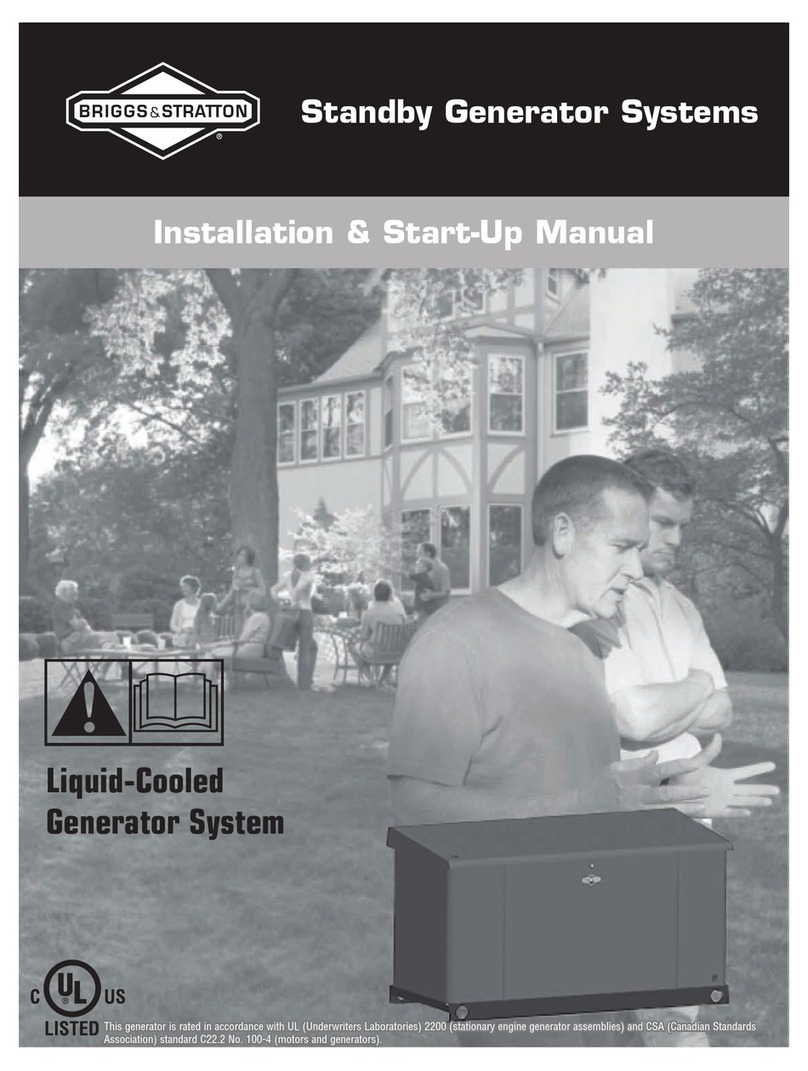
Briggs & Stratton
Briggs & Stratton Standby Generator Systems Installation & start-up manual
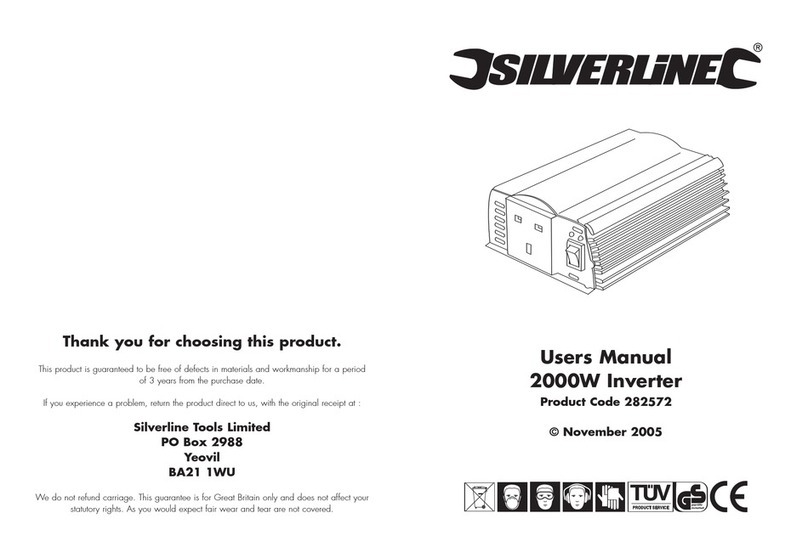
Silverline
Silverline 282572 user manual
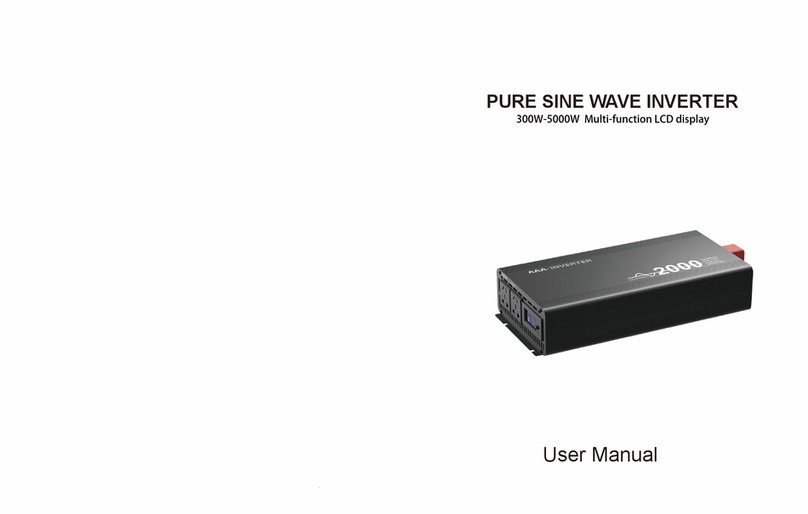
aaa-inverter
aaa-inverter CUA-300 user manual

Growatt
Growatt MIC 600-3300TL-X quick guide
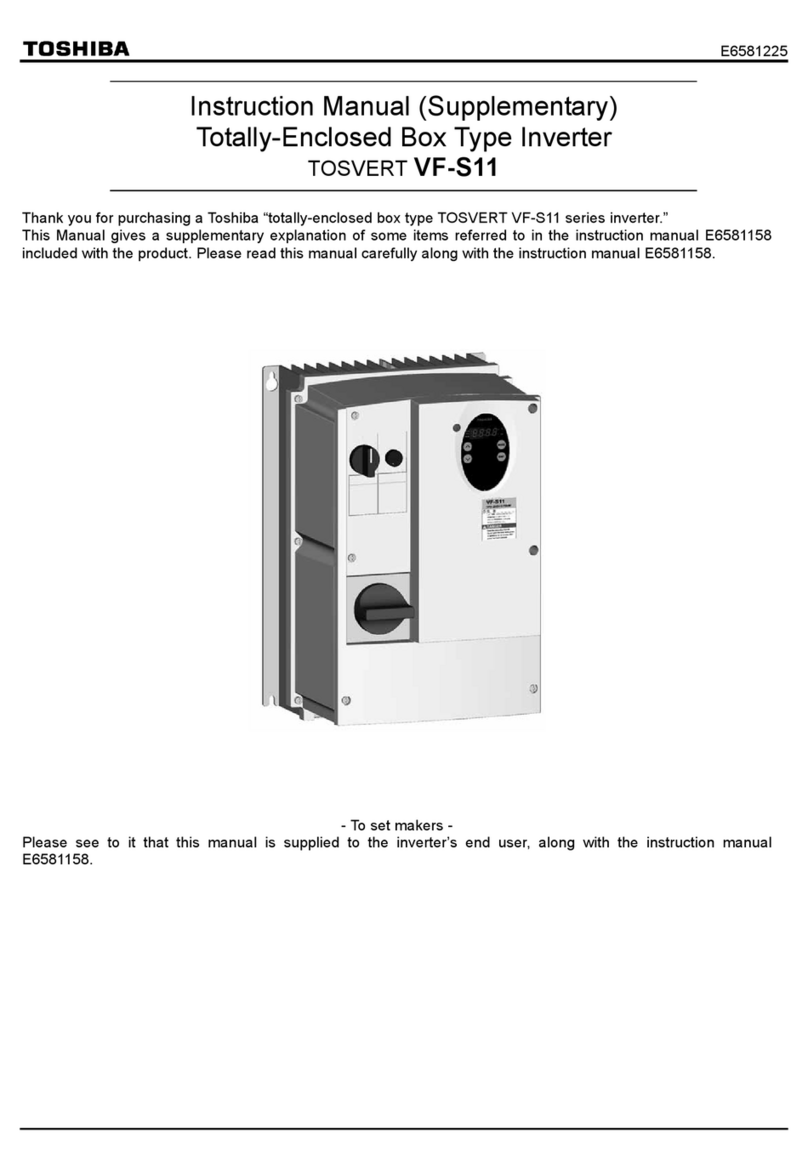
Toshiba
Toshiba TOSVERT VF-S11 Instruction manual supplement
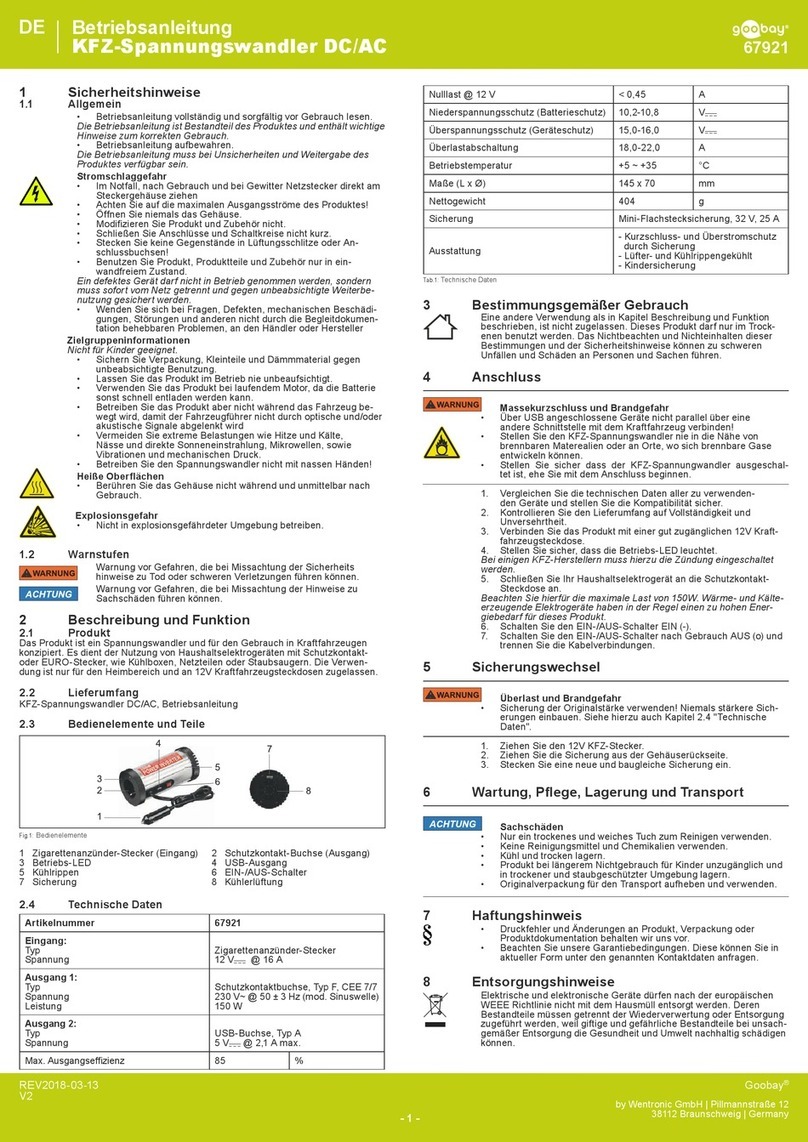
Goobay
Goobay 67921 user manual

